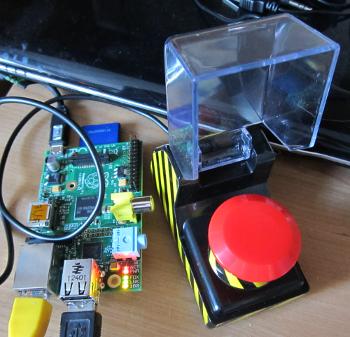What is keeping me from my Hi-res Pi blender rendering? Many things, including Joe's Robot Challenge.
One component of Joe's Robot Challenge is a button and for effect my Panic Button is a good fit.

Previously I compiled a kernel module to get it working, this time it made sense to search out a Python script.
I found http://www.righto.com/2010/04/usb-panic-button-with-linux-and-python.html which is a little dated but the only offer.
I copied the script to the Pi and ran it.
Then I tried to install the PyUSB library. But could not find the "pyusb" but could find "python-usb" that installed but still got the same error. Even the PyUSB creator suggests you use that package as it is "up to date".
Sadly it is not "up to date" on the Raspberry Pi Jessie latest version. I also tried install it via "pip"
But it says it is already installed :(
The instructions required uninstalling the current library, but that did not go well
Still I was able to download the latest version 1.0.0-a1 from https://github.com/walac/pyusb
Then
Drat! It still does not work. Maybe I should try old Python.
Double drat! Oh! Hang on. What is that last line? "Panic Button not found". I had not plugged the button in and it had detected it missing !!
Every time I pressed the button (or more accurately, released the button) "Pressed" was displayed.
So it works but not with Python3, annoying because we are using Python3 for everything else.
I could have written a new file but instead I just ran Python3 and copied and pasted the relevant lines.
Ha ha! That zero was when I had not touched the button and unsurprisingly 1 is when I had pressed (and released) the button.
The error is simply the button already not being attached to the default kernel HID driver.
One component of Joe's Robot Challenge is a button and for effect my Panic Button is a good fit.

Previously I compiled a kernel module to get it working, this time it made sense to search out a Python script.
I found http://www.righto.com/2010/04/usb-panic-button-with-linux-and-python.html which is a little dated but the only offer.
I copied the script to the Pi and ran it.
pi@raspberrypi:~/button_test $ sudo python PanicButton.py
Traceback (most recent call last):
File "PanicButton.py", line 10, in <module>
import usb.core
ImportError: No module named core
Then I tried to install the PyUSB library. But could not find the "pyusb" but could find "python-usb" that installed but still got the same error. Even the PyUSB creator suggests you use that package as it is "up to date".
Sadly it is not "up to date" on the Raspberry Pi Jessie latest version. I also tried install it via "pip"
pi@raspberrypi:~/button_test $ sudo pip install pyusb
Requirement already satisfied (use --upgrade to upgrade): pyusb in /usr/lib/python2.7/dist-packages
But it says it is already installed :(
The instructions required uninstalling the current library, but that did not go well
pi@raspberrypi:~/button_test $ sudo pip uninstall pyusb
Not uninstalling pyusb at /usr/lib/python2.7/dist-packages, owned by OS
Still I was able to download the latest version 1.0.0-a1 from https://github.com/walac/pyusb
Then
tar xzvf pyusb-1.0.0-a1.tar.gz
cd pyusb-1.0.0-a1/
sudo python setup.py install
sudo python3 setup.py install
pi@raspberrypi:~/button_test $ sudo python3 PanicButton.py
File "PanicButton.py", line 21
except Exception, e:
^
SyntaxError: invalid syntax
Drat! It still does not work. Maybe I should try old Python.
pi@raspberrypi:~/button_test $ sudo python PanicButton.py
Traceback (most recent call last):
File "PanicButton.py", line 33, in <module>
button = PanicButton()
File "PanicButton.py", line 17, in __init__
raise ValueError("Panic Button not found")
ValueError: Panic Button not found
Double drat! Oh! Hang on. What is that last line? "Panic Button not found". I had not plugged the button in and it had detected it missing !!
pi@raspberrypi:~/button_test $ sudo python PanicButton.py
Pressed
Pressed
Pressed
Every time I pressed the button (or more accurately, released the button) "Pressed" was displayed.
So it works but not with Python3, annoying because we are using Python3 for everything else.
I could have written a new file but instead I just ran Python3 and copied and pasted the relevant lines.
pi@raspberrypi:~/button_test $ sudo python3
Python 3.4.2 (default, Oct 19 2014, 13:31:11)
[GCC 4.9.1] on linux
Type "help", "copyright", "credits" or "license" for more information.
>>> import usb.core
>>> dev = usb.core.find(idVendor=0x1130, idProduct=0x0202)
>>> dev
<usb.core.Device object at 0xb67c5b70>
>>> dev.detach_kernel_driver(0)
Traceback (most recent call last):
File "<stdin>", line 1, in <module>
File "/usr/local/lib/python3.4/dist-packages/usb/core.py", line 695, in detach_kernel_driver
self._ctx.backend.detach_kernel_driver(self._ctx.handle, interface)
File "/usr/local/lib/python3.4/dist-packages/usb/_debug.py", line 52, in do_trace
return f(*args, **named_args)
File "/usr/local/lib/python3.4/dist-packages/usb/backend/libusb10.py", line 565, in detach_kernel_driver
_check(_lib.libusb_detach_kernel_driver(dev_handle, intf))
File "/usr/local/lib/python3.4/dist-packages/usb/backend/libusb10.py", line 357, in _check
raise USBError(_str_error[retval.value])
usb.core.USBError: Entity not found
>>> dev.ctrl_transfer(bmRequestType=0xA1, bRequest=1, wValue=0x300, data_or_wLength=8, timeout=500)[0]
0
>>> dev.ctrl_transfer(bmRequestType=0xA1, bRequest=1, wValue=0x300, data_or_wLength=8, timeout=500)[0]
1
>>>
Ha ha! That zero was when I had not touched the button and unsurprisingly 1 is when I had pressed (and released) the button.
The error is simply the button already not being attached to the default kernel HID driver.




![[Pay4Foss banner long]](http://pay4foss.org/pay4foss_bar.png)